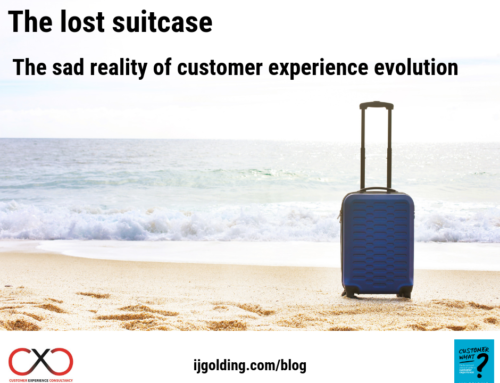Unless you have been living in a cave, you could not have avoided the recent horse meat scandal. The scandal is still raging in fact, with the focus most recently shifting to the meat that is really in our curries. One of the key words that underpins any customer experience is TRUST – something the consumer has precious little of in Britain at the moment. In the last few years we have learned how not to trust our banks. Now it seems that we find it hard to trust our favourite supermarkets.
Now more than ever, it is vital for organisations that play such a significant part in our lives, to work to put the trust back. To give us faith that as a customer, the businesses we transact with wants to do best by us. We want organisations to be seen to be putting their customers first, rather than the balance sheet.
Sticking with the supermarkets, you would have thought that the recent ‘crisis’ would have meant that they would question everything they do. Yes, it is now critical to ensure that the food they are selling is what it says on the tin. But what about other important information that forms part of the customer journey decision-making process?
In an ever more health conscious society, the nutritional content of the food we buy has become part of the customer journey when we conduct the weekly shop. As a man deep in the middle of my ‘mid life crisis’, wanting to know the amount of calories and saturated fat in the food I buy is now very important to me. Sadly, rather than being an area that the supermarkets are excelling at, I fear that they are failing to meet three important principles – HONESTY, TRANSPARENCY & CLARITY.
To explain what I mean, let me use an example. Over the weekend, I dragged my poor children to five supermarkets. In each, I purchased the same product – a tub of Beetroot salad. I wanted to see how simple it is to find out how many calories are in each. What did I find?
Well I would sum it up as confusion. I like to think that I am a fairly well-educated man, but I find it really hard to understand why and how the supermarkets publish the information on products in the way they do. It almost makes me think that they want customers to be confused. As a customer experience, I just find it irritating. Let’s have a look at each one in turn.
Firstly, where you find the information on the product is not that simple. Morrisons seem to be pretty good at doing this, most of the time publishing the information on the top. Looks pretty transparent to me……until you look closely, and realise that the information is for a third of a pack. Why? It might just be me, but what is the likelihood that anyone buying the product is going to eat a third of it? Surely it would make sense to tell me the information for the whole pack? My maths is not brilliant, but I am now being forced to exert some mental effort to figure out how many calories are in the whole pack. I just find it odd and unclear. So Morrisons – 10 out of 10 for visibility, 3.33 (roughly a third) out of ten for clarity.
Sainsburys have always been very good at displaying their traffic light system on packets. It was pretty easy to find this on the side of the tub. I now know why I should have concentrated more at school when being taught fractions! Sainsburys seem to think it is better to display the information in quarters – not thirds!! Why? They may think the information is clear, but I would like to bet that many consumers do not see the little white strip that states the information is only for a quarter of the pack. So Sainsburys – 10 out of 10 for visibility, 2.5 (a quarter) out of ten for clarity!
What about Marks & Spencer – surely they must be good at doing this! Wrong! M&S actually make it quite hard to find the information – in this case, it could be found in small print on a label on the bottom of the product. They are not even bothered with fractions. M&S would rather leave you to figure it out for yourself, quoting ‘typical values per 100g’. You have to go back to the top of the pack to determine that it is 250g, and then try to figure out what the total calorie content is. Complicated – you bet it is. Why can we not just have some clarity and transparency as a consumer? M&S – 3 out of 10 for visibility, 2 out of ten for clarity.
Next up was Tesco – a brand that has committed publicly to improving customer service. Like Sainsburys and Morrisons, the nutritional information was clearly visible on the side of the pot. However, Tesco, like M&S do not go for fractions. Tesco prefer to go for ‘heaped teaspoon’ as their measure – heaped teaspoon!! How am I supposed to know how many heaped teaspoons are in one pot. Whoever decided on the words to be used on the pot was not thinking about the customer experience – that is for sure! Tesco – 10 out of 10 for visibility, 1 out of 10 for clarity.
Last up on my mini test was Asda. Not as visible as Sainsburys, Morrisons or Tesco, they displayed the information on the back of the pot. They, like M&S, opted for the ‘typical values per 100g’ method, displayed next to a clearly visible 300g in three times the font! Why could they just not give me the values for 300g then?! Asda – 7 out of 10 for visibility, 3 out of ten for clarity.
I recognise that this is a pretty unsophisticated study. It is also not representative at all of the full range of products sold by these brands. However, as a mini test of the honesty, transparency and clarity of providing essential information to customers, it highlights some serious flaws. I find it very hard to believe that these labels are printed by someone who is THINKING in the same way a customer does. What the motivation of the labelling is, I can only speculate. It does appear as though the customer is still NOT front and centre of the decision-making process.
If we can learn anything from the horse meat scandal, is that organisations can ill afford to be untruthful to their customers. To restore consumer confidence in the brands we all use and love, we just need a little bit of common sense to prevail. Do not pull the wool over our eyes, just say it as it is – and let us make a decision as to whether to buy something or not.
Food labelling will continue to get ever more important in the food buying customer journey. I can only hope that the big supermarkets can continue to improve the visibility and clarity of the information – quickly!
What do you think of food labelling? Please feel free to comment on this, or any of my blog posts. I’m just off to eat some beetroot salad – I have plenty of it to get through!!
Next up













At the risk of sounding sexist, women have been dealing with this connundrum for some time, welcome aboard!
I think suppliers tend to give the nutritional content based on serving size. You might only eat a third of a pot in one sitting as a side salad with something else.
Furthermore, supplying the nutritional value by 100g means that you can work out point values easily for certain diet/weightloss programmes.
Also, a per 100g info table allows you some context. Since many products list the nutritional value per 100g (sometimes, as well as an additional ‘per serving size/half a pot’ info table) consumers are able to look at beetroot salad and compare it to a pasta salad and a pot of extra creamy coleslaw and so make an informed decision about which product is better for them as they can directly compare the fat, calorie and carb and others content very easily.
However, I agree with you. I’d love to see a ‘per 100g’ column and a ‘this pot contains’ column.
I’m pretty sure food labelling falls under DEFRA, check out their website on GOV.UK also, you’ve just missed a consultaion on food labelling…. https://www.gov.uk/government/publications/views-sought-on-front-of-pack-nutrition-labelling I’m sure they’ll publish the results in time….